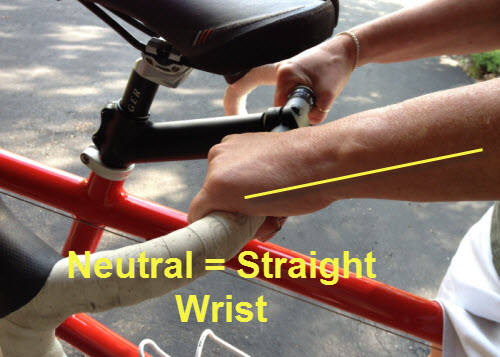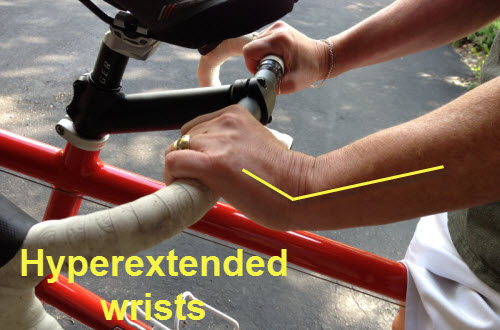Note: We've added a new category "Correcting Form" to help you identify and correct common form related problems you see or discomfort/pain your students are experiencing.
The problem diagnosing form, discomfort or pain issues while riding, is that they aren't always obvious when you're student is rested and fresh. Here's a good example:
Question from one of my regular students: "John, do you know I can keep my hands from getting numb - going to sleep?" "It happens here in class, but more so when I'm riding outside... any ideas?"
I've experienced this situation myself, as has the senior group fitness instructor Amy - but only while riding "The Bus" our tandem bicycle on long rides.
First I asked a simple question; "do you wear gloves when you're riding outside?"
"Sometimes I do, but never here in class. Because it happens both indoors and out, I don't think that's the problem."
She went on to explain; "I've researched it online and I think I've eliminated all the potential causes that I found." "It's frustrating for me because 30-40 min. into a ride, my hands start tingling and then fall asleep."
"If it's happening both indoors and out and with or without gloves, it's probably not a nerve compression in your hand problem. My guess it's probably your actual hand position on the bars... hop on this bike and let me take a look."
I had her jump on an Indoor Cycle in class and told her to get comfortable. Once she was in place, her hands were positioned like what's shown in this picture.

Proper hand position has straight wrists

"That would make sense. That wasn't discussed on any of the articles I found." "But I never ride like that so that couldn't be the problem either."
"Are you sure certain you never drop your elbows, which causes your wrists to collapse, when you have fatigued?"
I then went on to explain to her how subtle the change is and that when I had her drop her wrists, it didn't require changing her grip on the bars, only her dropping her elbows.
When we're fresh, we all sit up straight and tall. Everything about our form looks perfect. Yet as we fatigue, it's natural to experience small, often negative, changes in position. From my perch upon the instructor bike what I typically see is first shoulders tend to fall forward. This causes a little additional weight on your arms which result in your elbows collapsing in and downwards slightly. Because everything is connected, the lower position of your elbows, with no change in the position of your hands, naturally results in a greater angle of extension in your wrist.
Here are three suggestions you may use in class or on the road:
- Identify the problem. Describe the need to maintain a straight wrist and how it will add to everyone's comfort on the bike. Talk about hand numbness and tingling and ask if anyone has experienced it.
- Cue frequent hand position changes. If you're Spinning® instructor you're probably doing this already. I would add to your cuing the need to visually check that each new position results in a straight wrist. If you're not or if asking for hand position changes is something that you normally not do, this is a great time to start 🙂
- Watch for the signs of fatigue. You may see your student's form degrading, but they may not be able to sense it. Asking them to look down at their wrists, late in class. Asking them to correct it may have the effect of bringing everything else back in line... As I said before; "everything is connected."
Was this helpful to you [wlm_firstname]?
Originally posted 2012-05-30 13:21:10.
- Eagles pedaling through the air metaphor - April 21, 2024
- ICI Podcast 238 Meet Nerd Fitness Creator Steve Kamb - April 6, 2024
- ICI/PRO Podcast #113 Explosive Power pt 3 – Video PROfile with Tom Scotto from Stage 5 Cycling - March 31, 2024

This information was very needed for me as an instructor. I had reconstructive wrist surgery 2 years ago and it was not easy getting back in that saddle after a long break and at first I felt the numbness and tingling, but now I feel very comfortable on the bike and hand postions with the limited mobility that I have. I now know to look at my positioning of the wrist as well as my participants. Thanks for the info.
As a former competitive rower and rowing coach wrists are really important to me. The cue I use, particularly in my beginner classes, is to create the wrist position (and chain to the shoulders) that you would use to pick up a heavy suitcase. That creates a neutral wrist position, avoids elbows in and puts the shoulders back. As the students become more ‘sophisticated’ I address the pros/cons of right/wrong positioning. But, even then, when they are working hard and are fatigued the suitcase cue works the best.
I like that Christine + your description of “chain to the shoulders”
Love the “suitcase” cue, Christine. Will give it a test drive today!!
I think theres a real problem with communicating the potential consequences of poor techinque etc. to class members.
For the most part, there’s the denialism…..in that they *know* they don’t do whatever it is you’re suggesting (dropping the wrists when fatigued, say)…or, if they are aware there’s the response that they’ve always done that (…..with no problem)
Vivienne
Vivienne I teach to a lot of the same people – A types, many unwilling to “hear” my suggestions. I’ve taken to telling dramatic stories, frequently about my old life racing (and occasionally crashing) motorcycles. I talk about all the pressure on your wrists as you brake hard, momentum wanting to flip you over the handle bars – everything depends on your elbows up, wrists straight, transfer the force while staying strong.